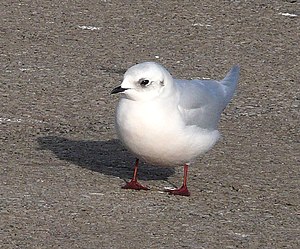Rose gull
| Rose gull | ||||||||||||
|---|---|---|---|---|---|---|---|---|---|---|---|---|

Rose gull in a simple dress |
||||||||||||
| Systematics | ||||||||||||
|
||||||||||||
| Scientific name of the genus | ||||||||||||
| Rhodostethia | ||||||||||||
| MacGillivray , 1842 | ||||||||||||
| Scientific name of the species | ||||||||||||
| Rhodostethia rosea | ||||||||||||
| ( MacGillivray , 1824) |
The rose gull ( Rhodostethia rosea ) is a species of seagull . It is sparsely distributed in the northern polar regions.
features
The rose gull can be confused with the little gull , but it is larger, has longer, more pointed wings and a wedge-shaped tail, which is atypical for seagulls . Its body shape cannot be confused with any other, it has a round head, a short, thin beak and a steeply sloping back. The beak is black in every season.
In its splendid dress , the seagull is white with silver-gray, light-colored wings (pale-gray stripes can be seen on the tips) and has a pink breast. Just behind the head is a noticeable black band. The feet are red-orange. In the plain dress , it has a gray neck and chest. The band behind the head has almost disappeared, only a gray line on each side of the neck reminds of it. There is a black stripe on the outer flag of the outermost hand wing.
The youth dress is white-gray. The wings are white except for the back half and a large triangular spot on the wrist. Behind the eye is a dark gray, crescent-shaped spot. The feet are gray-brown to orange.
Way of life
Rose gulls prefer to build their nests on beaches or inland. These consist of grass, leaves, moss and algae. Rose gulls breed in groups or colonies. The female lays three or less olive-colored, brown-spotted eggs in May. The breeding season depends on climatic conditions, usually the young hatch at the end of June, in cold years, and in Canada only in July. The young birds are fed fish and insects , they leave the nest 20 days after hatching. The rose gulls become sexually mature at 2 years of age.
Rose gulls eat crabs, insects and fish, which they prey by flying and thrusting just above the water like terns . They are often out in flocks of other gulls.
distribution
Rose gulls live on the tundra in Siberia, Norway and Canada, as well as locally in Greenland . They always move below the pack ice border, so they also come to Iceland and Scotland in winter. Rose gulls are rarer in northern China , Japan, the USA and central Europe.
supporting documents
literature
- Barthel, Dougalis: What is flying there? Franckh Kosmos, 2006
- Richard Sale: A Complete Guide to Arctic Wildlife . Christopher Helm, London 2006, ISBN 0-7136-7039-8
- AV Andre´ev and AJ Kondrat´ev: New data on the biology of the rose gull Rhodostethia rosea , Ornithologische Mitteilungen 65, 2013: 79–86
Web links
- Avibase
- Description of the rose gull (French)
- Rhodostethia rosea inthe IUCN 2013 Red List of Threatened Species . Listed by: BirdLife International, 2012. Retrieved January 14, 2014.